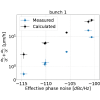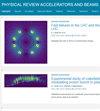Impact of beam coupling impedance on crab cavity noise induced emittance growth
IF 1.8
3区 物理与天体物理
Q3 PHYSICS, NUCLEAR
Physical Review Accelerators and Beams
Pub Date : 2024-07-08
DOI:10.1103/physrevaccelbeams.27.071001
引用次数: 0
Abstract
Crab cavities will be deployed as a part of the High Luminosity Large Hadron Collider (HL-LHC) upgrade to mitigate the luminosity reduction induced by the crossing angle at the main experiments (ATLAS and CMS). Two prototype crab cavities have been installed in the CERN Super Proton Synchrotron (SPS) in 2018 for studies with proton beams. An issue of concern is the transverse emittance growth induced by noise in the crab cavity radio frequency (rf) system, which is anticipated to limit the performance of the HL-LHC. In measurements conducted in the SPS in 2018, the crab cavity noise-induced emittance growth was measured to be a factor of 4 lower than predicted from the existing analytical models. In this paper, it is shown that the observed discrepancy is explained by damping effects from the beam coupling impedance, which were not included in the models up to now. Using the van Kampen mode approach, a new theory is developed, suggesting that the impedance can separate the coherent tune from the incoherent spectrum leading to an effective reduction of the crab cavity rf noise-induced emittance growth. This mechanism is validated in tracking simulations using the SPS impedance model as well as in dedicated experimental measurements conducted in the SPS in 2022. The implications for the HL-LHC project are discussed.

光束耦合阻抗对蟹腔噪声诱导发射率增长的影响
蟹腔将作为高亮度大型强子对撞机(HL-LHC)升级的一部分进行部署,以缓解主要实验(ATLAS 和 CMS)交叉角引起的亮度降低。2018 年,欧洲核子研究中心超级质子同步加速器(SPS)安装了两个原型蟹腔,用于质子束研究。一个值得关注的问题是蟹腔射频(rf)系统中的噪声引起的横向幅射增长,预计这会限制 HL-LHC 的性能。2018 年在 SPS 进行的测量中,测得蟹腔噪声引起的发射率增长比现有分析模型的预测值低 4 倍。本文表明,观察到的差异是由束流耦合阻抗的阻尼效应造成的,而迄今为止的模型中都没有包括这种效应。利用范坎彭模式方法,本文提出了一种新的理论,认为阻抗可以将相干调谐从非相干频谱中分离出来,从而有效降低蟹腔射频噪声引起的发射增长。这一机制在使用 SPS 阻抗模型进行的跟踪模拟以及 2022 年在 SPS 进行的专门实验测量中得到了验证。讨论了这一机制对 HL-LHC 项目的影响。
本文章由计算机程序翻译,如有差异,请以英文原文为准。
求助全文
约1分钟内获得全文
求助全文
来源期刊

Physical Review Accelerators and Beams
Physics and Astronomy-Surfaces and Interfaces
CiteScore
3.90
自引率
23.50%
发文量
158
审稿时长
23 weeks
期刊介绍:
Physical Review Special Topics - Accelerators and Beams (PRST-AB) is a peer-reviewed, purely electronic journal, distributed without charge to readers and funded by sponsors from national and international laboratories and other partners. The articles are published by the American Physical Society under the terms of the Creative Commons Attribution 3.0 License.
It covers the full range of accelerator science and technology; subsystem and component technologies; beam dynamics; accelerator applications; and design, operation, and improvement of accelerators used in science and industry. This includes accelerators for high-energy and nuclear physics, synchrotron-radiation production, spallation neutron sources, medical therapy, and intense-beam applications.
 求助内容:
求助内容: 应助结果提醒方式:
应助结果提醒方式:


